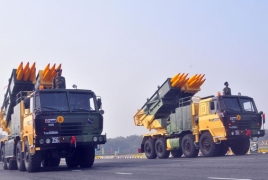
Armenia signed over $1.5 billion in defense contracts with India between 2022 and 2023, according to a report by the Russian International Affairs Council (RIAC) cited by Vedomosti.
The agreements include acquisitions of 214mm Pinaka multiple rocket launchers, 155mm ATAGS artillery systems, ZADS counter-drone systems, Akash-1S and upcoming Akash-NG air defense systems, Konkurs anti-tank missile systems (produced under Russian license), mortars, and various munitions.
France has also become a major defense partner for Armenia, with contracts worth approximately $250 million signed between 2023 and 2024. These include GroundMaster 200 radars, Mistral 3 man-portable air defense systems, and Caesar self-propelled artillery units.
The report notes Armenia’s last major defense deal with Russia, valued at $400 million, was signed in 2021 but remains only partially fulfilled.
According to the Stockholm International Peace Research Institute (SIPRI), from 2011 to 2020, Russia accounted for 94% of Armenia’s arms imports. However, by 2024 this share had dropped to 10%, largely due to difficulties in fulfilling deliveries amid the war in Ukraine, as stated by Armenian Security Council Secretary Armen Grigoryan.
The report adds that perceptions of Russia in Armenia have shifted significantly. Once seen as a friendly state, Russia is now increasingly viewed as a source of political threats. A 2023 survey by the International Republican Institute placed Russia third behind Azerbaijan and Turkey in perceived threat rankings. Contributing factors include Russia’s muted response during the 2020 Nagorno-Karabakh war and subsequent Armenia-Azerbaijan border clashes.
Against this backdrop, Armenian leadership has pursued a policy of diversifying foreign relations, strengthening ties with the West. In January 2025, Armenia and the U.S. signed a strategic partnership declaration. In February, Armenia’s parliament approved legislation initiating the EU membership process.
Despite these developments, Russia remains Armenia’s largest economic partner. In 2024, trade with Russia accounted for over 41% of Armenia’s total trade ($12.4 billion, including $3.1 billion in Armenian exports), up from 37% in 2023. Russian cumulative investment doubled over 2022–2023, reaching $4 billion. The report notes, however, that much of this growth stems from re-exports of Western goods to Russia and Russian goods to global markets via Armenia.
Political analyst and Caucasus expert Artur Ataev emphasized that Armenia’s engagement with India is part of a long-term strategy to diversify arms sources and reduce political dependence on Russia. France is also viewed as an alternative arms supplier. Still, Ataev noted, Armenia does not seek to completely sever military ties with Moscow.
Stanislav Pritchin, head of the Central Asia section at the Russian Academy of Sciences' IMEMO institute, argued that Indian and French weapons cannot fully replace Russian and Soviet systems currently in use by the Armenian military. He views diversification as politically motivated, while maintaining that Armenian forces still rely on CSTO standards and require regular maintenance and parts for Russian equipment.
Pritchin also noted that Armenia still remains a vital transit hub for Russian foreign trade. While both Moscow and Yerevan benefit from this arrangement, a change in sanctions or trade routes could significantly reduce volumes, possibly reverting to pre-2020 levels.

